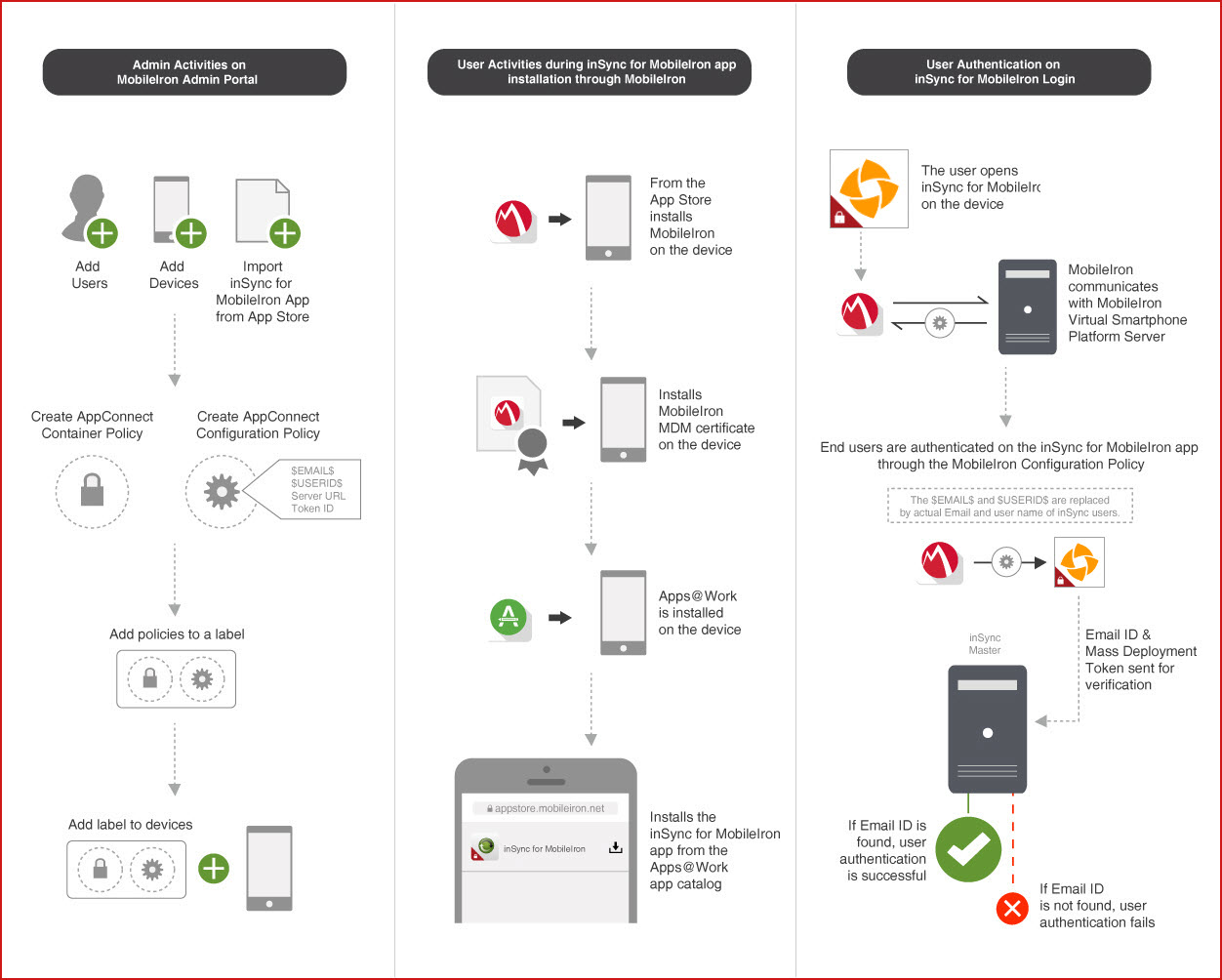inSync for MobileIron FAQs
Overview
This topic contains answers to frequently asked questions on the inSync for MobileIron app.
Questions
Device compatibility matrix
inSync for MobileIron app deployment
Answers
Device compatibility matrix
What are the OS platforms and OS versions and devices with which the inSync for MobileIron app is compatible?
The following table lists the OS platforms, OS versions, and devices with which the inSync for MobileIron app is compatible.
| OS Versions | Compatible with |
|---|---|
| iOS 5, iOS 6, iOS 7 | iPhone, iPad, and iPod touch |
inSync for MobileIron and MobileIron Integration
Admin workflow
On the MobileIron ADMIN PORTAL, the administrator performs the following steps:
- Add users and devices. You will also import the inSync for MobileIron app from the App Store. For more information on how to import the inSync for MobileIron app, see Import inSync for MobileIron app from the App Store.
- Create configuration and container policies. In the configuration policy, you specify the key-value pair required by the inSync for MobileIron to authenticate inSync users. In the container policy, you allow or restrict inSync users from sending print requests from their iOS devices, from performing a copy-and-paste operation from files within the inSync for MobileIron app to any other application, and from opening files by using other applications. For more information on how to create configuration policies, see Create and manage AppConnect configuration policies. For more information on how to create container policies, see Create and manage AppConnect container policies.
- Create a label and assign your policies to that label and then apply this label to a device. This step is required to silently activate the inSync for MobileIron app on user devices and to push policy updates on the inSync for MobileIron app without user intervention. For more information, see Create and manage labels.
User workflow
On the iOS device, the inSync users perform the following steps:
- Install MobileIron (from the App Store) on the iOS device.
- After initial MobileIron configuration, install the inSync for MobileIron app from Apps@Work Store.
- Open the inSync for MobileIron app on the iOS device.
For more information, see Install and configure the Mobile@Work client on an iOS device.
User authentication workflow
After inSync users install the inSync for MobileIron on their iOS device, the following communication and authentication process occurs:
- MobileIron communicates with the MobileIron Virtual Smartphone Platform Server for the configuration policy. During this process, the $EMAIL$ and $USERID$ values in the configuration policy are replaced with the actual Email ID and the user names of the inSync users.
- MobileIron then sends the configuration policy to the inSync for MobileIron app.
- The inSync for MobileIron sends the Email ID and the IMD token to the inSync Master for verification.
- The inSync Master searches for the email ID. If the inSync Master finds a match, the user authentication for the inSync for MobileIron app is successful. If the inSync Master does not find a match for the email ID or if the IMD token does not match, the user authentication fails and the inSync mobile app login window appears.
How does MobileIron integration help?
MobileIron integration with the inSync for MobileIron app helps in many ways. A few benefits are as follows:
- You can distribute the inSync for MobileIron app on multiple iOS devices.
- You have granular control over print, copy-paste, and share features.
- You can ensure compliance of security policies for users.
- You have complete control on how users install, activate, and use the inSync for MobileIron app on their iOS devices.
inSync for MobileIron app deployment
Can we distribute the inSync for MobileIron app on multiple iOS devices?
Yes. You can distribute the inSync for MobileIron app on multiple iOS devices. For more information, see Create and manage AppConnect configuration policies. If you want to silently activate the inSync for MobileIron app on user devices, see Can users silently activate the inSync for MobileIron app?
Can users silently activate the inSync for MobileIron app?
Yes. After inSync users install the inSync for MobileIron app on their iOS device, the following communication and authentication process occurs:
- MobileIron communicates with the MobileIron Server for the configuration policy. During this process, the $EMAIL$ and $USERID$ values in the configuration policy are replaced with the actual Email ID and the user names of the inSync users.
- MobileIron then sends the configuration policy to the inSync for MobileIron app.
- The inSync for MobileIron app sends the Email ID and the IMD token to the inSync Master for verification.
- The inSync Master searches for the email ID. If the inSync Master finds a match, the user authentication for the inSync for MobileIron app is successful. If the inSync Master does not find a match for the email ID or if the IMD token does not match, the user authentication fails and the Druva Mobile App login window appears.


